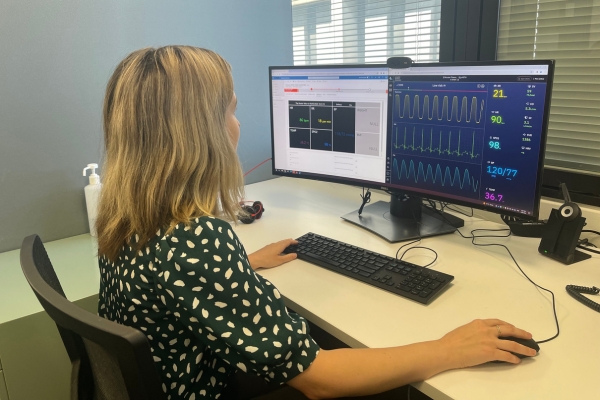About
Our Virtual Ward advances at-home care for patients with serious conditions
- Home
- About
- Latest news
- Our Virtual Ward advances at-home care for patients with serious conditions

30 May 2024
Austin Health’s Virtual Ward is the first in Victoria to provide at-home care using wearable devices for patients with acute leukaemia and those recovering from cardiac surgery.
After first piloting virtual care in 2021 with funding from the Department of Health, the Hospital in the Home & Virtual Care (HITH-VC) Virtual Ward services are now ‘business as usual’ cementing Austin Health’s place as a leader in this new frontier of health care.
There are up to 10 patients in the Virtual Ward at any time being monitored via wearable devices. The ward currently focuses on cardiac and hematology patients: in addition to providing early supported discharge after cardiac surgery, the service manages patients with acute leukaemia, heart failure and cardiac rhythm disturbances. These patients have ‘high clinical acuity’, requiring close oversight and prompt escalation of care in the event of clinical deterioration.
“Patient safety is always our first priority,” says Medical Director of HITH-VC Dr Mark Horrigan.
Patients must meet a set of criteria to be suitable for virtual care.
“We look for patients with a realistic expectation of steady recovery who will thrive at home, and who have supportive relatives to participate in their care.”
Angela Sullivan, Nurse Unit Manager of Austin HITH-VC explains that virtual care patients are set up with a specially designed watch or patch to monitor physiological parameters, such as vital signs and heart rhythm, which can be seen in real time by hospital clinicians. The patients have regular teleconference calls with a multi-disciplinary team tailored to their needs; this may include doctors, nurses and pharmacists.
“It’s replicating what happens in a hospital ward: nurses check vital signs three times a day and patients call us if they feel unwell,” says Angela.
There has been overwhelmingly positive feedback from virtual care patients, who say recovering at home is preferable to the noise and distractions of busy hospital wards. This model of care is also of benefit to patients who live in rural and remote locations who can get home sooner and still access the skills of our clinicians.
Leukaemia patient Desi Iliopoulos receives her care from the comfort of home with virtual care. She says she remains in constant contact with her care team and feels safe and supported.
“It’s been a game changer for me. It changed my whole psychology. I can get through this and not have to spend so much time in hospital.”
Home-based care has been linked to improved health outcomes for patients. Benefits for patients include greater comfort and convenience, an easier transition back to community care and reduced risk of infection while in hospital. For hospitals, virtual care can open spaces for other patients to be admitted, improving hospital flow.
Advancing virtual care with new technology
In February, Austin Health reported a significant advance in patient data management, by integrating data from virtual care wearable devices directly into the electronic medical record. For the first time, a clinician looking after a patient in the Emergency Department, or on an inpatient ward, can see the observations that were collected while the patient was at home earlier that day.
This is a huge leap forward in improving the flow of patient information in hospitals and a model that other hospitals can adopt.
Each patient’s wearable device sends data to Austin Health’s CRM (Customer Relationship Management) system from which it is uploaded to the patient’s electronic medical record. Director of EMR and ICT Services Alan Pritchard explains the CRM was developed in-house to meet Austin Health’s needs, and is designed to be adaptable to meet the inevitable changes to this emerging technology.
.jpg)


